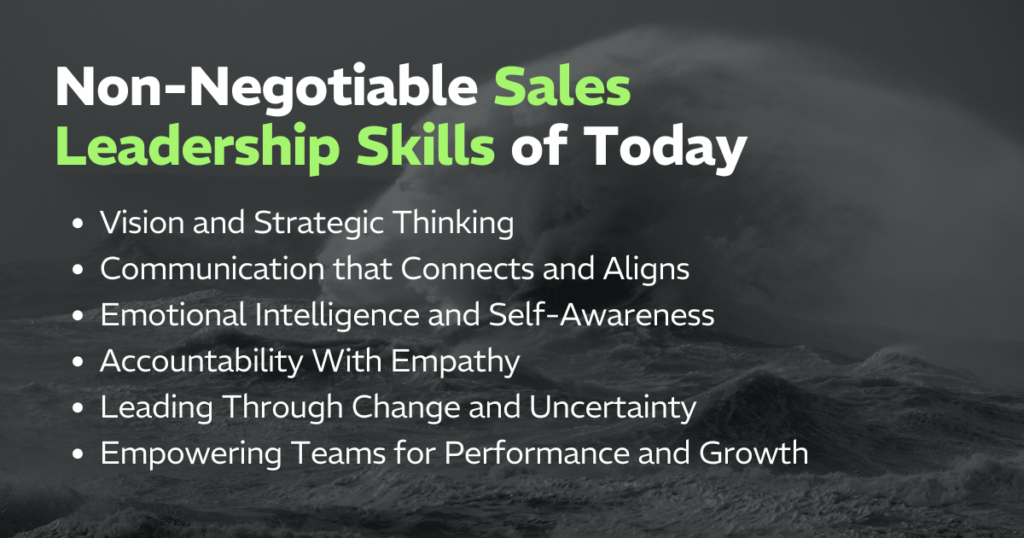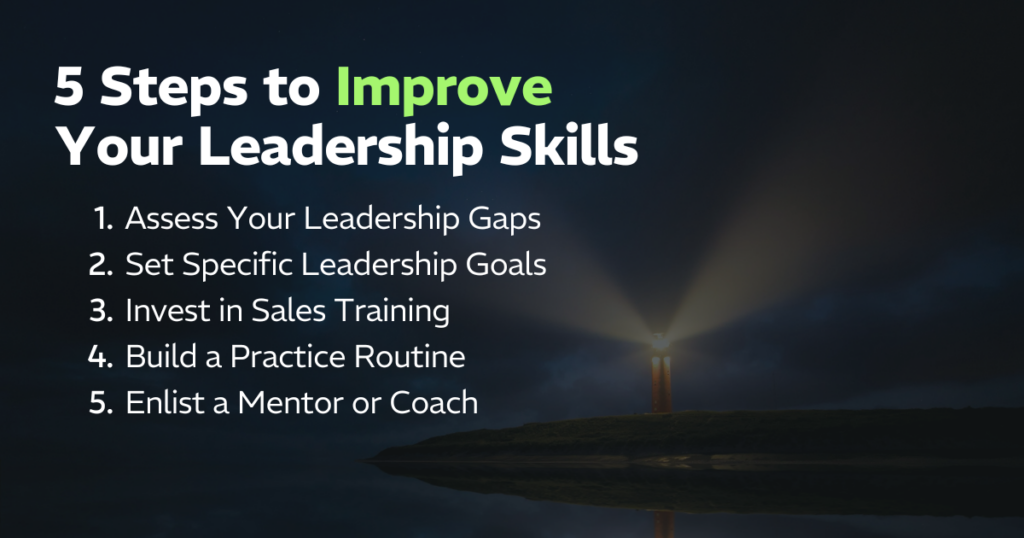Sales leadership skills are at the heart of every high-performing team. These are the capabilities that set great leaders apart — not just in how they hit numbers, but in how they inspire people, build culture, and navigate change.
Today’s sales leaders are managing more than pipelines. They’re managing people through rapid transformation. With shifting buyer behaviors, remote teams, and rising performance pressure, the expectations on leaders are higher than ever.
This moment demands a new kind of leader: one rooted in purpose, powered by emotional intelligence, and committed to continuous development. A human-centered leader.
With the right skill set and mindset, you can build trust, drive results, and create the kind of culture where your team can thrive. Let’s explore the essential sales leadership skills that will help you lead with clarity, consistency, and impact.
What Is Sales Leadership?
Sales leadership is the ability to influence, inspire and empower your team members to perform at their best. It’s not about control. It’s about creating clarity, confidence and connection. While sales management ensures tasks are completed, sales leadership ensures people grow.
It’s about understanding where the team is, where it needs to go, and how to bring everyone along the journey. Leadership means painting the vision, removing obstacles, and creating an environment where people can thrive even in uncertainty.
Sales Management vs. Sales Leadership
Sales managers track numbers. Sales leaders transform people.
The difference is in the depth. Management skills ensure performance in the short term. Effective leadership invests in the long game: building trust, culture, and consistent excellence.
Great sales managers execute. But great sales leaders elevate. They prioritize culture as much as performance, and they lean into hard conversations when needed to move the business forward. They know that sustainable success comes not just from process but from purpose.
When you lead with intention, you don’t just hit goals. You create a team that’s resilient, engaged and committed to common goals.
The Non-Negotiable Sales Leadership Skills of Today
There’s no single formula for being a good leader, but there are specific, repeatable skills that today’s most effective sales leaders consistently develop. These skills form the foundation for trust, performance, and growth. Whether you’re managing a small team or leading a large organization, mastering these core competencies is non-negotiable in today’s fast-paced, people-first selling environment.
Vision and Strategic Thinking
When you walk into a team meeting, does your team know where they’re headed? Great sales leaders align daily actions with long-term purpose. They help their teams zoom out and see the big picture.
Vision provides focus, especially when distractions and shifting priorities make it easy to get off track. The most successful leaders make time for strategy, not just execution. They step back, connect the dots, and help the team align on what matters most.
When I work with leaders, I often ask: “Can your team repeat your vision in one sentence?” If not, start there.
Get clear. Get aligned. And keep repeating it.
Communication that Connects and Aligns
A good message isn’t just delivered once. It’s reinforced consistently. People remember what you repeat, especially when you say it in a way that resonates.
Strong leaders practice active listening, too. It builds clarity and trust.
I worked with one vice president of sales who opened every Monday meeting with the same two questions: “What matters most this week?” and “How does that connect to our mission?” It became a rhythm. And it worked.
Great leaders also create communication rituals that keep teams grounded and connected, whether in-person or remote. Great communication creates alignment, drives accountability, and helps you stay in sync with every player on the field.
Emotional Intelligence and Self-Awareness
Your team is always watching you. They see how you respond to stress. How you handle setbacks. How you celebrate wins.
High-performing teams reflect their leaders. When you lead with presence, empathy and self-awareness, you give others permission to do the same.
Self-awareness isn’t just a leadership advantage; it’s a requirement. Leaders who understand their own triggers, blind spots and behavioral patterns can lead more calmly and intentionally, even in high-stakes situations.
Start by blocking 15 minutes every Friday to reflect: How did I show up this week? What could I have done differently?
Better yet, ask your team: “What’s something I may not be seeing?” That kind of vulnerability models the very behavior you want to cultivate in your work environment.
Accountability With Empathy
Accountability and empathy are not mutually exclusive. In fact, they strengthen each other.
You earn the right to challenge people when they know you care about them.
I once coached a frontline manager who was avoiding a hard conversation with a rep who was missing quota. Once he led with empathy (“How are you, really?”), the entire conversation shifted. They made a plan together. Trust deepened. Performance improved.
This is the hallmark of an effective leader.
Leading Through Change and Uncertainty
Today’s sales environment is unpredictable. The best leaders bring clarity to chaos. They demonstrate change leadership skills that help people adapt and grow.
When change hits, your team needs more communication, not less. They need context, transparency and a sense of control to make informed decisions and stay on track.
That’s why we talk so much about human-centered leadership. It’s not enough to survive change. You have to lead through it.
Empowering Teams for Performance and Growth
Great sales leaders don’t just manage pipelines. They develop people.
That means coaching consistently. Creating space for feedback. And encouraging goal setting and growth goals alongside revenue goals.
Development isn’t just about skills; it’s about confidence. It’s about helping each person on your team understand their strengths and how they contribute to team success. It’s about making coaching a normal, weekly rhythm, not a once-a-quarter formality.
Sales leaders who prioritize development help their team stay adaptable, engaged, and consistently improving.

Action Plan: How to Improve Your Leadership Skills
Learning about sales leadership is one thing. Applying it is another. Leadership growth happens when insight meets action. The following steps offer a practical roadmap you can use to embed what you’ve learned and become a more effective, intentional leader. This is where theory turns into transformation.
Step 1: Assess Your Leadership Gaps
Every leadership journey begins with self-awareness. Before you can grow, you have to understand where you stand.
This isn’t about perfection. It’s about honesty. Take time to reflect: What are your strengths? Where are your patterns of struggle? When are you at your best as a leader, and when do you fall short?
Seek input. Ask your team, your peers, your mentors. Use tools like 360-degree feedback to gather perspectives. Patterns will emerge. Use them to identify where you can lean in and grow.
Growth starts with the courage to look in the mirror.
Step 2: Set Specific Leadership Goals
“Be a better leader” is a noble intention. But it’s not a measurable goal. The best leaders get specific.
Choose one or two focus areas from your self-assessment of your team leader skills. These should tie back to real behaviors, things you can see, track, and celebrate. Think small shifts that create big ripple effects.
Examples:
- Make space for weekly coaching conversations
- Open team meetings with a recognition ritual
- Slow down to listen more deeply in 1:1s
By tying your development to clear behaviors, you’ll make progress visible — for yourself and your team.
Step 3: Invest in Sales Training
Growth is never a solo sport. Even the best leaders need to level up their tools and tactics.
This is where professional development becomes strategic. Seek out sales leadership training programs, workshops, and peer learning groups that challenge your assumptions and expand your capabilities.
Effective sales training isn’t just for frontline reps. As a leader, you set the tone. Investing in your growth models the very mindset you want your team to adopt.
You’re not just learning for yourself. You’re learning to lift others.
Step 4: Build a Practice Routine
Leadership isn’t a light switch. It’s a discipline. To sustain growth, you need to make development a habit.
Block time on your calendar. Journal each week. Prepare for tough conversations. Debrief after team meetings. The repetition builds confidence and clarity.
This is how good intentions become consistent behaviors — the foundation of trustworthy leadership.
Step 5: Enlist a Mentor or Coach
Even the strongest leaders need a sounding board. Someone to hold up the mirror. Someone to challenge your thinking.
Having a mentor or coach accelerates your growth curve. You gain perspective. You stay accountable. You get support when the work feels heavy.
In my work, I’ve helped thousands of leaders build the confidence and communication skills to lead transformational change — in themselves and their teams.
You don’t have to do it alone. And you shouldn’t.

Lead With Impact
Leadership is a decision. Every day, you decide what kind of experience you’re creating for your team.
Choose to lead with purpose. Invest in your skills.
This is what the best work environments are built on. The habits and behaviors of a great leader. And the courage to show up, grow and handle even the toughest conflict resolution moments with confidence.
It’s all part of mastering human-centered leadership keynote skills that help teams thrive.
Ready to elevate your leadership? Book Ryan Estis for a keynote that inspires performance, purpose and powerful change.




![[RYAN] Featured_Leadership Development Planning for Human Centered Growth Group climbing a hill together](https://ryanestis.com/wp-content/uploads/bb-plugin/cache/RYAN-Featured_Leadership-Development-Planning-for-Human-Centered-Growth-1024x538-panorama-ba61edeb5d6c961b544c5c7916ed5ca0-.png)






